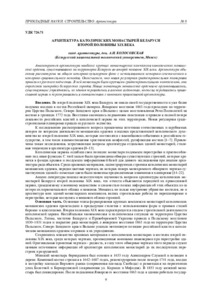Please use this identifier to cite or link to this item:
https://elib.psu.by/handle/123456789/7811Full metadata record
| DC Field | Value | Language |
|---|---|---|
| dc.contributor.author | Колосовская, А. Н. | - |
| dc.date.accessioned | 2014-11-18T13:27:32Z | - |
| dc.date.available | 2014-11-18T13:27:32Z | - |
| dc.date.issued | 2014 | - |
| dc.identifier.citation | Вестник Полоцкого государственного университета. Серия F. Строительство. Прикладные науки : научно-теоретический журнал. - 2014. - № 8. – С. 9-14. | ru_RU |
| dc.identifier.issn | 2070-1683 | - |
| dc.identifier.uri | https://elib.psu.by/handle/123456789/7811 | - |
| dc.description | Architecture Catholic Monasteries Belarus the Second Half of the Xix Century / A. Kolosovskaya | ru_RU |
| dc.description.abstract | Анализируется архитектура наиболее крупных монастырских комплексов католических монашеских орденов, существовавших на территории Беларуси во второй половине XIX века. Архитектура объектов рассмотрена на общем историко-культурном фоне с использованием историко-генетического и историко-сравнительного методов. Отмечается, что новая регулярная градостроительная планировка пришла из русского зодчества. В ней монастыри были крупными градостроительными комплексами, они определяли застройку белорусских городов. Новые монастыри монашеских орденов не организовывались, существующие упразднялись, их здания переводились в военное ведомство, костелы передавались православной церкви и перестраивались в соответствии с канонами православной архитектуры.= The architecture of the largest monasteries of Catholic monastic orders that existed on the territory of Belarus in the second half of the XIX century is analyzed. Architecture of objects is considered by the common historical and cultural background with the use of historical-genetic, historical and comparative methods. It is noted that a new regular town planning layout came from the Russian architecture. Monasteries were large urban complexes, they determined the development of Belarusian cities. New monasteries of monastic orders were not organized, existing were abolished, their buildings were transferred to the military, churches passed right-glorious church and rebuilt in accordance with the canons of the Orthodox architecture. | ru_RU |
| dc.language.iso | ru | ru_RU |
| dc.publisher | Полоцкий государственный университет | ru_RU |
| dc.relation.ispartof | Веснік Полацкага дзяржаўнага ўніверсітэта. Серыя F, Будаўніцтва. Прыкладныя навукі | be_BE |
| dc.relation.ispartof | Herald of Polotsk State University. Series F, Civil engineering. Applied sciences | en_EN |
| dc.relation.ispartof | Вестник Полоцкого государственного университета. Серия F. Строительство. Прикладные науки | ru_RU |
| dc.relation.ispartofseries | Серия F. Строительство. Прикладные науки;2014. - № 8 | - |
| dc.rights | open access | ru_RU |
| dc.subject | История архитектуры | ru_RU |
| dc.subject | католические монастыри | ru_RU |
| dc.subject | орденские монастыри | ru_RU |
| dc.subject | архитектурно-пространственная структура | ru_RU |
| dc.subject | Беларусь XIX в. | ru_RU |
| dc.title | Архитектура католических монастырей Беларуси второй половины XIX века | ru_RU |
| dc.type | Article | ru_RU |
| dc.identifier.udc | 72(091) | - |
| Appears in Collections: | 2014, № 8 | |
Items in DSpace are protected by copyright, with all rights reserved, unless otherwise indicated.
